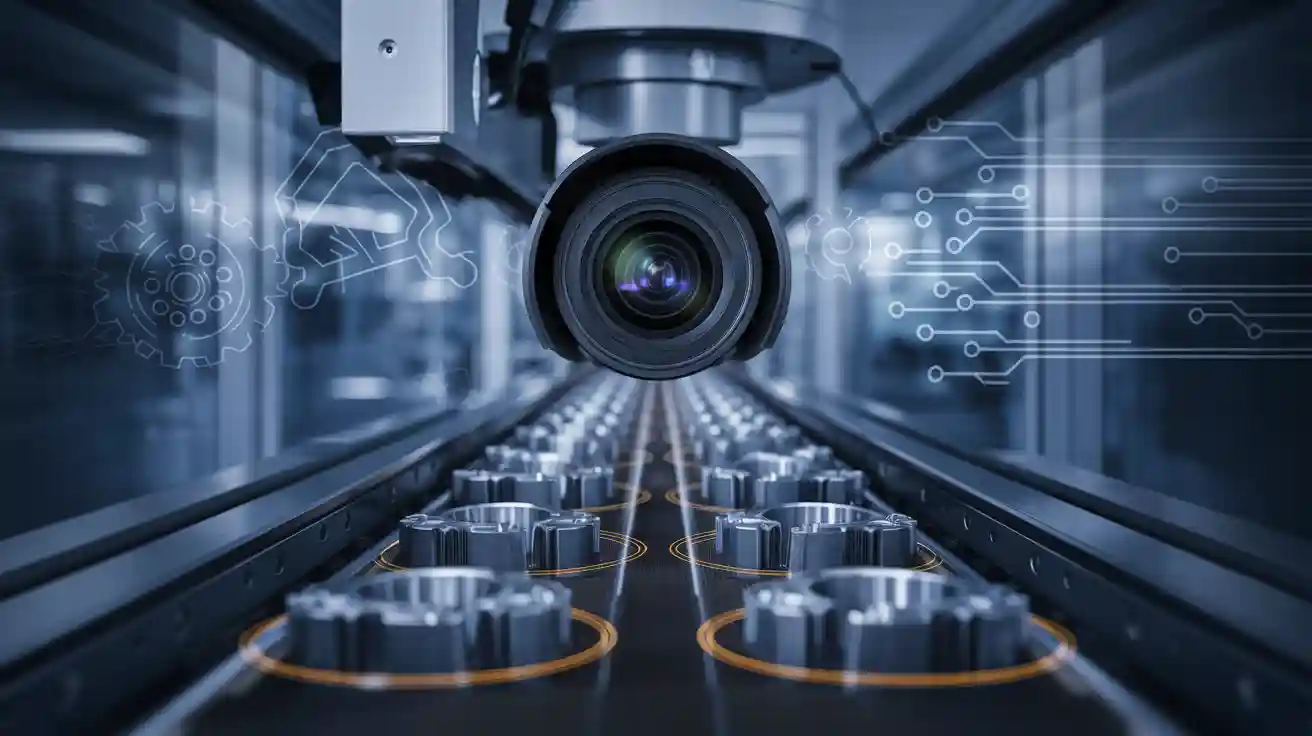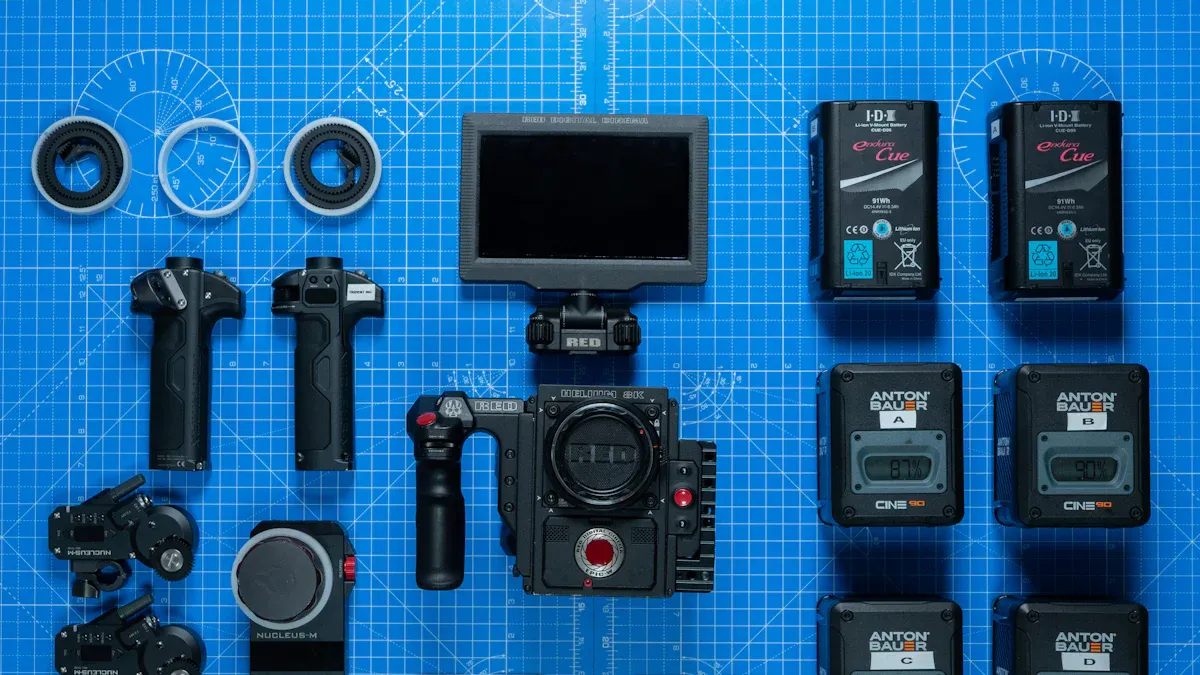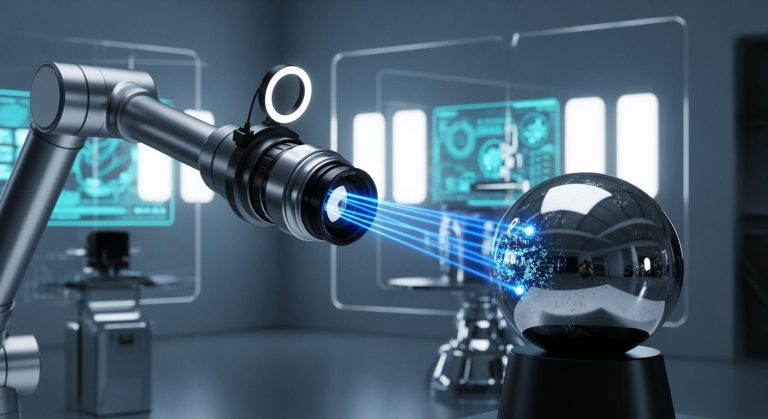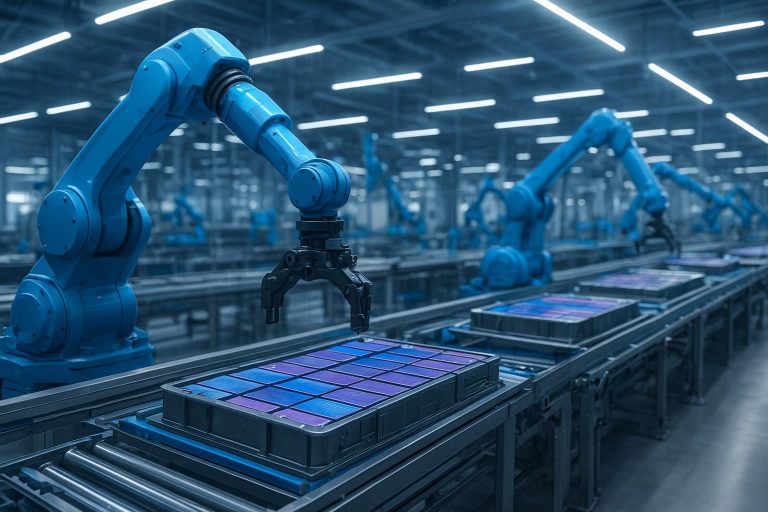
Imagine a factory where a camera struggles to spot tiny cracks in products, leading to costly recalls. In every industrial lens machine vision system, the lens serves as the foundation for image clarity and accuracy. Industrial lenses focus the target onto the camera sensor, shaping the entire machine vision process. High-quality lenses can boost defect detection rates by over 40% and, when paired with advanced camera and AI technologies, reduce false positives by up to 25%. The right lens ensures each system captures sharp details, allowing the machine vision system to deliver reliable inspection results. Choosing the proper lens remains essential for any industrial lens machine vision system, as it determines how well the camera, sensor, and system work together.
Key Takeaways
- Industrial lenses are crucial for clear, accurate images in machine vision systems, directly affecting defect detection and measurement precision.
- Choosing the right lens type and matching it to the camera sensor size and mount prevents image distortion and ensures full use of sensor resolution.
- Focal length, working distance, and aperture must be balanced to capture the right field of view and maintain sharp focus across objects at different distances.
- High-quality lenses reduce distortion and image errors, improving inspection reliability and supporting precise measurements in demanding industrial environments.
- Ruggedized and advanced lenses, like telecentric and autofocus types, enhance system durability and flexibility, enabling better performance in harsh conditions and complex tasks.
Role of Industrial Lenses in Machine Vision
Image Formation in Machine Vision Systems
Industrial lenses play a central role in the image formation process of any machine vision camera. These lenses focus light from the target object onto the sensor, creating a clear and precise image for further image processing. The lens determines several critical parameters, including working distance, imaging size, field of view, and depth of field. Each of these factors shapes how the system captures and interprets visual information.
- Industrial lenses control optical magnification, which sets the ratio between the actual object size and its image on the sensor. This magnification is essential for accurate scaling and measurement in machine vision.
- The focal length of the lens affects both the working distance and the characteristics of the image. A longer focal length narrows the field of view, while a shorter one widens it.
- Different lens types, such as fixed focus, zoom, microscope zoom, and telecentric lenses, serve specific imaging needs. Each type impacts image quality and accuracy in unique ways.
Tip: Choosing the right lens type for your industrial lens machine vision system ensures the camera captures the necessary details for reliable inspection and measurement.
The table below shows how lens selection influences distortion and resolution, which are vital for image clarity:
| Lens Type | Distortion Level | Resolution Impact | Performance Effect |
|---|---|---|---|
| Fisheye Lens | High | Low | Negative |
| Rectilinear Lens | Low | High | Positive |
Selecting a lens that matches the sensor size and image circle prevents vignetting and distortion. Telecentric and low-distortion lenses minimize parallax and geometric errors, which is crucial for precise measurements. Lens parameters such as focal length, aperture, and working distance also influence field of view, brightness, and sharpness. These factors are all critical for clear and accurate imaging in machine vision applications.
Lens design matters as well. Achromatic and apochromatic lenses use multiple elements to reduce chromatic aberration and other distortions, such as astigmatism and field curvature. Aberrations can cause image blur and distortion, like barrel and pincushion effects, which degrade image clarity. The modulation transfer function (MTF) measures how well a lens maintains contrast and resolution, directly linking lens selection to image quality in machine vision.
Impact on Accuracy and Performance
The quality of the lens directly affects the accuracy and reliability of any industrial lens machine vision system. High-quality lenses provide uniform distortion, stabilized elements, and minimal image drift. These features ensure consistent and precise imaging, which is essential for dynamic measurements in automated inspection systems. For example, in 2D and 3D metrology, such as automotive part inspection or electronics surface defect detection, a high resolution lens enables the system to identify even the smallest defects.
Machine vision technology has transformed automated inspection across many industries. The right lens, tailored to the specific requirements of the system, is critical for achieving optimal inspection results. Careful evaluation of lens specifications and compatibility with the camera setup ensures the system delivers accurate and repeatable outcomes.
In the contact lens manufacturing industry, companies have moved from manual inspection to high-speed, high-accuracy automated visual inspection systems. These systems rely on advanced AI and machine vision hardware, but the quality of the optical components, especially the lens, remains fundamental. High-quality lenses allow the system to detect minute cosmetic defects, eliminate human error, and ensure 100% quality inspection.
Industrial environments often present harsh conditions, such as vibration and shock. Ruggedized machine vision lenses are designed to withstand these challenges. They feature wider focus rotation angles and floating designs, which enable precise focus adjustments and maintain excellent image quality across different distances and sensor types. Their durability reduces system failures and supports continuous, precise imaging, which is critical for manufacturing tasks like semiconductor inspection and robotics sensing.
Advancements in lens technology continue to expand the capabilities of modern machine vision systems. Autofocus lenses speed up setup and improve precision. P-Iris technology enhances aperture control, increasing image clarity and depth of field. Ruggedized lenses ensure consistent performance in tough environments. Short-Wave Infrared (SWIR) lenses allow detection beyond visible light, revealing details that standard lenses cannot. Accessories such as polarizers and cylindrical lenses reduce glare and increase contrast, helping the system detect fine features.
- Autofocus and adjustable lenses provide flexibility for different inspection tasks.
- Ruggedized designs improve reliability and reduce downtime.
- Enhanced lens features support integration with AI and real-time image processing.
These advancements lead to higher accuracy, faster training, and improved automated feature processing in machine vision hardware. The right lens selection ensures the industrial lens machine vision system delivers reliable, high-quality results, even in demanding industrial settings.
Types of Industrial Lenses for Machine Vision

Fixed Focal Length Lenses
Fixed focal length lenses, also known as entocentric lenses, remain the most common choice in machine vision. These lenses collect light rays that diverge from the optical axis and offer a simple, reliable solution for many industrial applications. Their affordability and versatility make them ideal for standard inspection tasks where the object distance does not change much.
| Characteristic / Use Case | Description |
|---|---|
| Lens Type | Entocentric lens collecting rays diverging from the optical axis |
| Cost and Versatility | Affordable and versatile, suitable for standard machine vision applications |
| Optical Parameters | Focal length and sensor size allow easy calculation of field of view and working distance |
| Focus Adjustment | Focus adjustable from minimum working distance to infinity |
| Iris Control | Usually mechanically controlled iris for manual adjustment of F/#, light intensity, depth of field, and resolution |
| Limitations | Significant perspective errors and geometric distortion; not suitable for precision measurement |
| Mechanical Issues | Mechanical adjustments can introduce play, reducing consistency and repeatability |
| Typical Use Cases | Applications prioritizing cost-effectiveness and versatility over precision; object distance relatively fixed or standard |
| Unsuitable Applications | Not ideal for very consistent/repeatable settings or high precision metrology |
These lenses work best in environments where cost and flexibility matter more than extreme accuracy. However, they may introduce perspective errors and distortion, making them less suitable for precision measurement.
Variable Magnification Lenses
Variable magnification lenses, including zoom and liquid lenses, allow real-time adjustment of focal length. These lenses help machine vision systems adapt to changing object distances or inspection tasks. Robotics and automated inspection lines often use these lenses to handle products of different sizes or positions.
- Zoom lenses adjust focal length mechanically, providing variable magnification for flexible imaging.
- Liquid lenses use electrical signals to change focus quickly, improving system responsiveness.
- Telecentric zoom lenses maintain constant perspective and magnification, which is vital for precise measurements in semiconductor inspection.
Variable magnification lenses enable continuous adjustment of the working area and minimize distortion. They support high-precision applications where the system must zoom and focus without losing accuracy.
Telecentric Lenses
Telecentric lenses provide constant magnification, so objects appear the same size no matter where they are in the field of view. These lenses eliminate parallax errors and minimize distortion, making them essential for precision measurement tasks in machine vision.
- Telecentric lenses offer a wide depth of field, allowing sharp imaging of thick or complex objects.
- They produce high image quality and sharp edges, which improves defect detection in quality control.
- These lenses reduce the impact of ambient light changes, ensuring consistent image quality in industrial environments.
Industries such as automotive and electronics manufacturing rely on telecentric lenses for tasks that demand accuracy and repeatability. Bi-telecentric designs further improve magnification constancy and field depth, addressing the most demanding measurement needs.
Specialty Lenses
Specialty lenses address unique challenges in specific machine vision applications. Macro lenses provide high magnification for close-up inspection of small components like electronic chips. Wide-angle and fisheye lenses deliver large fields of view, which helps in warehouse surveillance or area coverage tasks where geometric accuracy is less important.
- Line scan lenses support continuous imaging for materials such as metal sheets and textiles on production lines.
- Ruggedized lenses withstand harsh environments, including vibration, temperature changes, and dust.
- Custom-designed lenses solve integration challenges in embedded and IoT vision systems.
Specialty lenses enhance image quality, measurement accuracy, and system integration. They allow machine vision systems to meet the diverse needs of modern industrial environments.
Key Selection Factors in Industrial Lens Machine Vision System
Selecting the right lens for a machine vision system requires careful consideration of several technical and practical factors. Each choice directly impacts image quality, inspection accuracy, and the overall effectiveness of the industrial lens machine vision system. Below, the most important selection criteria are explained with practical examples.
Sensor Compatibility and Lens Mount
A lens must match the camera sensor in both size and mounting type. If the lens image circle is smaller than the sensor, vignetting occurs, causing dark corners and loss of detail. When the lens image circle is larger, the system may not use the full sensor resolution, wasting potential image quality.
The lens mount type also matters. Common mounts include C-Mount, CS-Mount, and M12. Each has a specific flange back distance, which is the space between the lens flange and the sensor plane. Using the wrong mount or failing to use the correct spacer can prevent proper focus. For example, a C-Mount lens on a CS-Mount camera needs a 5 mm spacer to achieve focus.
| Factor | Explanation |
|---|---|
| Sensor Size | Lens must cover the sensor to avoid vignetting and ensure full resolution. |
| Lens Mount Type | Must match camera (C-Mount, CS-Mount, M12) for secure attachment and correct focus. |
| Flange Back Distance | Impacts focus; varies by mount type. |
| Use of Spacers/Adapters | Needed when mixing mounts to achieve proper focus. |
| IR Cutoff Filter & Sensor Window | Extra glass can affect flange distance and compatibility. |
Tip: Always check both sensor size and mount type before selecting a lens to avoid costly installation errors.
Focal Length and Field of View
Focal length determines how much of the scene the lens captures. A short focal length gives a wide field of view, which is useful for inspecting large objects or areas. A long focal length narrows the field of view but increases magnification, making it easier to see small details or distant objects.
The relationship between focal length, sensor size, and working distance defines the field of view. The formula is:
Field of View (FOV) = (Sensor Size × Working Distance) / Focal Length
For example, a lens with a 12 mm focal length on a 1/2" sensor at a 200 mm working distance will capture a much wider area than a 50 mm lens at the same distance. Choosing the right focal length ensures the system captures the necessary details without missing defects or wasting processing power on unnecessary background.
Working Distance and Depth of Field
Working distance is the space between the lens and the object. This distance affects both magnification and depth of field (DOF). A short working distance allows for higher magnification, which is ideal for inspecting tiny features. However, it reduces the depth of field, making it harder to keep objects at different heights in focus.
A longer working distance increases the depth of field, allowing multiple objects at varying distances to appear sharp. Adjusting the aperture also changes the depth of field. A smaller aperture (higher f-number) increases DOF but reduces image brightness, which may require stronger lighting or longer exposure times. For example, inspecting a circuit board with components at different heights benefits from a longer working distance and a smaller aperture to keep all parts in focus.
Note: Balancing working distance and aperture is crucial for applications where objects have varying heights or when the system must inspect multiple planes at once.
Distortion and Image Quality
Distortion affects the accuracy of measurements and the reliability of defect detection. The most common types of distortion in industrial lenses include:
- Barrel distortion: Straight lines bow outward, common in wide-angle lenses.
- Pincushion distortion: Lines bend inward, typical in telephoto lenses.
- Wave (mustache) distortion: A mix of barrel and pincushion, causing wavy lines.
- Trapezoidal (keystone) distortion: Parallel lines converge or diverge due to misalignment.
| Distortion Type | Cause/Characteristic | Impact on Image Quality and Industrial Use |
|---|---|---|
| Barrel Distortion | Lines curve outward; common in wide-angle lenses | Distorts geometry, making straight lines appear bowed |
| Pincushion Distortion | Lines bend inward; typical in telephoto lenses | Compresses image, affecting shape accuracy |
| Wave Distortion | Wavy lines from combined barrel and pincushion effects | Difficult to correct, impacts measurement |
| Trapezoidal Distortion | Misalignment causes parallel lines to converge/diverge | Alters parallelism, reduces measurement accuracy |
High-quality lenses minimize these distortions, preserving geometric fidelity and ensuring precise measurements. For machine vision hardware used in inspection or metrology, even small distortions can lead to false readings or missed defects.
⚠️ Common Mistakes:
- Selecting lenses based only on price, ignoring performance needs
- Failing to match lens and sensor compatibility
- Overlooking environmental conditions
- Choosing lenses with insufficient resolution for the application
Additional Considerations
- Aperture: Controls image brightness and depth of field. Adjust in combination with lighting and camera settings.
- Application Requirements: Consider object characteristics, required measurement accuracy, and environmental factors such as vibration or temperature.
- Cost and Technological Maturity: High-quality lenses cost more but deliver better performance and reliability. Lower-cost options may compromise accuracy and efficiency.
- Operating Wavelength: Some applications require lenses optimized for infrared or ultraviolet imaging.
Selecting the right lens involves balancing these factors to meet the specific needs of the machine vision system. A well-chosen lens ensures the system delivers accurate, reliable results and integrates smoothly with other components.
Machine Vision System Applications and Lens Impact

Automated Inspection
Lens selection plays a vital role in automated inspection across many industries. Manufacturers rely on machine vision to spot defects, measure parts, and ensure product quality. The right lens improves image sharpness and reduces distortion, which leads to more reliable defect detection. For example, telecentric lenses provide constant magnification and eliminate parallax errors. This ensures accurate measurements even when object distances change. On automated lines with products of different sizes, telecentric zoom lenses allow flexible, precise inspection without frequent recalibration.
| Lens Type | Practical Impact on Inspection Accuracy | Manufacturing Application Example |
|---|---|---|
| Telecentric lenses | Consistent measurements, no parallax errors | Precision gauging systems |
| Telecentric zoom lenses | Adjustable magnification, accurate inspection of varied products | Automated inspection lines |
| Bi-telecentric lenses | No perspective distortion, improved repeatability | Semiconductor and electronics defect detection |
| Long working distance | Clear imaging of large or irregular objects | Automotive and aerospace manufacturing |
| Specialized electronics | Enhanced detection of microscopic defects | Circuit board inspection |
High-quality lenses also speed up inspection by reducing the need for extra calibration. Poor lens quality can slow down processing and cause missed defects. Regular calibration and proper lighting further improve reliability.
Precision Measurement
Machine vision applications often require high-precision measurement. Industrial lenses directly affect image clarity, resolution, and measurement accuracy. Telecentric lenses maintain the same magnification, even if the object moves closer or farther from the lens. This feature is critical for tasks like component alignment and dimensional checks. Fixed focal length lenses also provide stable magnification and low distortion, making them suitable for fixed setups.
- Telecentric lenses reduce perspective errors and keep distortion below 0.1%.
- Ultra-wide depth of field in these lenses supports accurate measurement, even if the object shifts slightly.
- The Modulation Transfer Function (MTF) measures lens quality and affects edge detection, which is important for precise measurement.
Proper calibration using dot or square grids helps correct any remaining lens distortion. This step ensures that the system delivers true measurements for industrial applications.
Challenging Industrial Environments
Industrial environments often expose lenses to dust, vibration, temperature changes, and contamination. These factors can degrade image quality and reduce system accuracy. Ruggedized lenses help solve these problems. They use fixed focus and aperture settings to prevent shifts caused by vibration. O-rings and hydrophobic coatings seal the lens against dust and moisture. Stability features, such as glued elements and clamps, keep the lens aligned during shocks.
- Long working distance lenses allow imaging from a safe distance, protecting the system from heat or debris.
- Telecentric lenses maintain consistent image scale, even if the object moves due to vibration.
- Industrial-grade lenses have strong mechanical designs to withstand harsh conditions and keep performance stable.
Selecting the right lens for each application ensures reliable machine vision, even in tough industrial environments. Matching lens features to the needs of the application leads to better inspection of objects and more accurate results in all industrial applications.
Industrial lenses drive high-performance machine vision by delivering sharp focus, low distortion, and durability in demanding environments. Selecting the right lens type and understanding key criteria—such as focal length, aperture, and sensor compatibility—ensures reliable inspection and long-term system stability.
Checklist for Lens Selection:
- Match lens to sensor size and mount
- Choose appropriate focal length and field of view
- Consider ruggedization for harsh conditions
- Verify resolution and contrast requirements
For complex applications, industry experts recommend consulting professionals or manufacturer resources to optimize lens choice and avoid costly errors.
FAQ
What is the most important factor when choosing an industrial lens for machine vision?
Lens compatibility with the camera sensor stands as the most important factor. This ensures the system captures clear images without vignetting or distortion. Proper matching supports accurate inspection and reliable performance in industrial environments.
How does lens distortion affect machine vision applications?
Lens distortion can change the shape of objects in images. This leads to inaccurate measurements and missed defects. High-quality lenses with low distortion help maintain precise inspection and measurement results.
Why do some applications require telecentric lenses?
Telecentric lenses keep object size constant, even if the object moves closer or farther from the lens. This feature proves essential for tasks that demand high measurement accuracy, such as electronics inspection or precision gauging.
Can ruggedized lenses improve system reliability?
Ruggedized lenses resist vibration, dust, and temperature changes. These features help maintain image quality and reduce system failures in harsh industrial settings. They support continuous operation and stable inspection results.
How does working distance influence lens selection?
Working distance sets the space between the lens and the object. Short distances allow for higher magnification but reduce depth of field. Longer distances increase depth of field, making it easier to keep objects at different heights in focus.
See Also
Understanding The Role And Function Of Lenses In Machine Vision
The Impact Of Structured Light On Improving Machine Vision
Complete Overview Of Machine Vision Applications In Industrial Automation
Essential Insights Into Semiconductor-Based Machine Vision Technologies
An In-Depth Explanation Of Electronics In Machine Vision Systems








